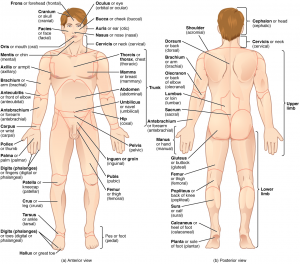Lab Exercise 1: Introduction to Human Anatomy
- Anatomical Position
- Surface Anatomy
- Directional Terms
- Body Planes and Regions
Anatomy is the study of body structures. This can involve study of the large parts such as muscle and organs like the heart; called gross or macroscopic anatomy or, study of structures such as what heart
muscle cells look like with the aid of microscopes, microscopic anatomy. When we study what
these structures do and how they do it, that is the realm of physiology. The set of exercises in Week 1
is on the organization of the human body. What are the structures on the surface of the human body,
how do we name them, how do we describe their location(s) relative to each other and are we able to
do these with uniformity among anatomists and physiologists? These are some of the questions we
aim to be able to answer by the end of the week’s exercises.
Learning Outcomes
At the end of this lab, you should be able to
- describe the anatomical position, and explain its importance;
- use appropriate anatomical terminology to describe body regions, orientation and direction;
- recognize body planes and be able to determine whether a section is in the frontal, transverse or sagittal plane;
- name the body cavities, and indicate the important organs in each;
- name and describe the serous membranes of the ventral body cavities;
- identify the quadrants and nine regions of the abdomen on a torso model or image;
- list the 11 organ systems of the body;
- place major organs in the correct organ system when presented with a list of organs.
Anatomical position
In clinical settings and when referring to specific areas of the human body, the body is oriented in a universal position called the anatomical position. In the anatomical position (Figure 1.1), the body is upright with the feet pointed forward, eyes looking straight ahead, and arms hanging at the sides with the palms facing forward. An individual in the anatomical position is said to be prone when lying face down and supine when lying face up.
Directional Terminology
With the body in the anatomical position, specific terms are used to describe the location of a human body part relative to another (Figure 1.2 a). A lateral view of an individual in anatomical position (Figure 1. 2b) illustrates the front and back orientation. Note that directional terms are with reference to the anatomical position.
(a) Lateral view (b) Anterior view
Figure 1.2. Directional References
Click the link below to watch the an animation on anatomical position and directional terms:
In quadrupeds (four-legged animals), the directional terms are somewhat different
| Table 1.1. Directional Terms Used for Humans | ||
| Term | Meaning | Example |
| Superior | Above | The mouth is superior to the chin |
| Inferior | Below | The navel is inferior to the breastbone |
| Cephalic/cranial | Toward the head | In humans, analogous to superior |
| Caudal | Toward the tail | In humans analogous to inferior |
| Anterior | To the front | The breast bone is anterior to the lungs |
| Posterior | To the back | The lungs are posterior to the breastbone |
| Medial | Toward the midline | The nose is medial to the cheek bones |
| Lateral | Away from the midline or medial plane | The kidneys are lateral to the navel |
| Ventral | Belly side | In humans, analogous to anterior |
| Dorsal | Back side | In humans, analogous to posterior |
| Superficial | Toward or at the body surface | The skin is superficial to skeleton |
| Deep | Away from the body surface | The dermis is deep to the epidermis |
| Proximal | Nearer the trunk or attached end | The elbow is proximal to the hand |
| Distal | Farther from the trunk or attached end | The fingers are distal to the wrist |
Surface and regional anatomy
The body is divided into two main regions, the axial (along the body’s main axis) and appendicular regions (the appendages and structures attaching them to the main body axis). The axial region includes the head, neck, and trunk; it runs along the vertical axis of the body. The appendicular region includes the limbs and the girdles that attach them to the trunk. These structures on the body surface constitute the body’s surface anatomy; these are shown for the anterior structures (Figure 1. 3a) and posterior structures (figure 1.3b) using the common and anatomical names. Body surface features are used as anatomical landmarks to assist in locating internal structures; as a result, many internal structures are named after an overlying surface structure.
Body Regions and Anatomical Landmarks
Figure 1.3. Regions of the Body showing anatomical landmarks
Open Stax Anatomy and Physiology CC By 3.0
Click the link below to connect to the interactive object which enables learners to identify a person’s regional body parts.
Body Planes and Sections
The body sections is narrated and illustrated in the animation; click on the link below:
Major Body Cavities
Click the link below to access this interactive learning exercise. In this interactive object, learners examine the locations of major body cavities and their protective membranes. A drag-and-drop exercise completes the activity.
Abdominopelvic Quadrants and Regions
Organ Systems



